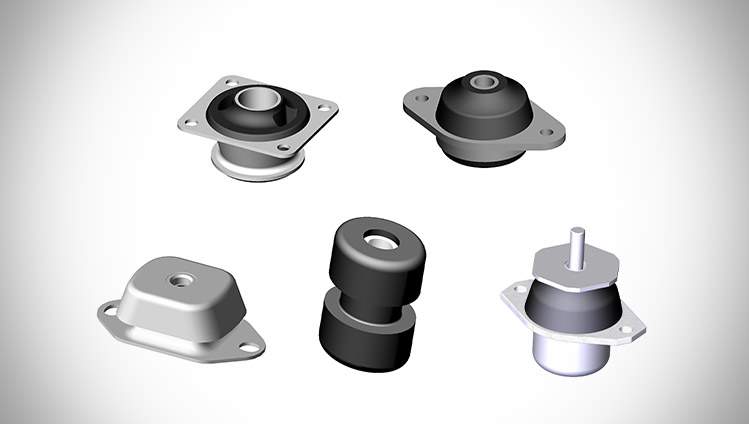There are four main types of engine mounts: rubber mounts, hydraulic mounts, polyurethane mounts, and electronic active mounts. Each type serves different vehicle needs based on vibration control and durability requirements.
Engine mounts play a crucial role in your vehicle’s performance. The right type can mean the difference between a smooth ride and constant vibration. Let’s examine each type in detail.

What are the different types of engine mounts?
Not all engine mounts work the same way. Different vehicles need different solutions based on their engine size, power, and intended use.
The four primary engine mount types are: conventional rubber mounts for basic vibration control, hydraulic mounts for luxury vehicles, polyurethane mounts for performance cars, and active electronic mounts for advanced vibration management.
Detailed breakdown of engine mount types
Here’s what makes each mount type unique:
| Mount Type | Best For | Lifespan | Cost Range |
|---|---|---|---|
| Rubber Mounts | Economy cars, daily drivers | 5-7 years | $50-$150 |
| Hydraulic Mounts | Luxury vehicles, SUVs | 7-10 years | $150-$400 |
| Polyurethane Mounts | Sports cars, modified vehicles | 10+ years | $100-$300 |
| Electronic Mounts | High-end luxury vehicles | 8-12 years | $400-$800 |
Special considerations for each type
- Rubber Mounts
- Most common in Toyota Corolla, Honda Civic
- Affordable but wear faster
- Simple to replace
- Hydraulic Mounts
- Used in Lexus, Mercedes-Benz
- Contain fluid for better damping
- More complex installation
- Polyurethane Mounts
- Popular for Toyota Supra, Subaru WRX
- Stiffer for better handling
- Transfer more vibration
- Electronic Mounts
- Found in Audi A8, BMW 7 Series
- Adjust stiffness electronically
- Most expensive to replace
How many engine mountings are in a car?
You might be surprised how many mounts your engine actually uses. The number varies based on your vehicle’s design and engine configuration.
Most cars have 3-4 engine mounts. Transverse-mounted engines typically use 3 mounts, while longitudinal engines often use 4. Heavy-duty vehicles may have additional mounts for support.
Engine mount count by vehicle type
Different vehicles require different numbers of mounts:
| Vehicle Type | Mount Count | Typical Positions |
|---|---|---|
| Compact Sedan | 3 | Right, left, and rear |
| Full-size SUV | 4 | Right, left, front, and rear |
| Pickup Truck | 4-5 | Additional transmission mount |
| Sports Car | 3-4 | Reinforced mounts for high power |
Why mount numbers matter
- Weight Distribution
- More mounts spread engine weight evenly
- Prevents stress on individual mounts
- Vibration Control
- Additional mounts reduce vibration transfer
- Especially important for large engines
- Engine Stability
- Proper mounting prevents excessive movement
- Protects other components from damage
Toyota Camry models typically use 3 mounts, while the Tundra pickup requires 4 for its heavier engine. Always check your specific model’s requirements.
Do I need to replace all four motor mounts?
When one mount fails, you might wonder about the others. Replacing all mounts at once can save money in the long run.
You don’t always need to replace all motor mounts. Replace only the damaged ones if they’re relatively new. For older vehicles or high mileage, replace all mounts together for balanced performance.
When to replace all mounts
Consider these factors when deciding:
| Situation | Recommended Action | Reason |
|---|---|---|
| One mount failed | Replace just that mount | Cost-effective if others are good |
| High mileage (100k+) | Replace all mounts | Others will fail soon |
| Performance vehicle | Replace as complete set | Ensures even stiffness |
| Noticeable vibration | Inspect all, likely replace multiple | Multiple mounts often wear together |
Cost comparison: single vs complete replacement
- Single Mount Replacement
- Parts: $50-$200
- Labor: 1-2 hours
- Total: $150-$400
- Complete Set Replacement
- Parts: $200-$600
- Labor: 3-4 hours
- Total: $500-$1,200
For Toyota Highlander or similar SUVs, I recommend complete replacement after 80,000 miles. The labor savings outweigh doing them separately.
Which is better, a rubber or a hydraulic engine mount?
Choosing between rubber and hydraulic mounts depends on your vehicle and driving needs. Each has distinct advantages for different situations.
Hydraulic mounts are better for luxury vehicles needing smooth rides, while rubber mounts work well for economy cars. Hydraulic lasts longer but costs 2-3 times more than rubber mounts.
Direct comparison of rubber and hydraulic mounts
Here’s how they stack up against each other:
| Feature | Rubber Mounts | Hydraulic Mounts |
|---|---|---|
| Vibration Control | Good | Excellent |
| Durability | 5-7 years | 7-10 years |
| Cost | $50-$150 | $150-$400 |
| Maintenance | Simple replacement | May require special tools |
| Best For | Toyota Corolla, Honda Civic | Lexus ES, Mercedes E-Class |
Choosing the right type for your vehicle
- Consider Your Budget
- Rubber costs less upfront
- Hydraulic lasts longer
- Evaluate Your Needs
- Daily drivers do fine with rubber
- Luxury cars need hydraulic’s smoothness
- Check Vehicle Specifications
- Some cars require specific types
- Aftermarket options may exist
For Toyota Avalon owners upgrading from rubber to hydraulic, the improvement in ride quality is noticeable. The extra cost is worth it for many drivers.
Conclusion
Engine mounts come in rubber, hydraulic, polyurethane, and electronic types. Most cars use 3-4 mounts, and complete replacement is often best for high-mileage vehicles.